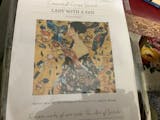Georges Seurat (4)
Georges Seurat (1859–1891) was the French artist who essentially turned painting into a science experiment. Known for developing the technique of Pointillism, Seurat took color theory and geometry to a whole new level, using tiny dots of color to create intricate, visually dynamic works. It’s like he looked at the brushstroke and thought, “What if I broke it down to the smallest, most precise units possible?” His method required a lot of patience (we’re talking thousands of dots), but the result was a smooth, almost magical blending of color when viewed from a distance.
Seurat’s most famous painting, A Sunday Afternoon on the Island of La Grande Jatte, is a masterpiece of this technique. The scene, with its park-goers in top hats and elegant dresses, looks deceptively simple at first glance. But when you step back, the carefully placed dots of color come together to form a vibrant, cohesive image. It’s a perfect example of how Seurat’s work was as much about creating a visual experience as it was about exploring the science of color and optics. Sadly, Seurat's career was cut short—he died at just 31—but his innovative approach had a lasting impact, influencing many artists and helping to pave the way for modern abstract art. So, next time you're admiring one of his works, just remember: the dots didn’t paint themselves!














